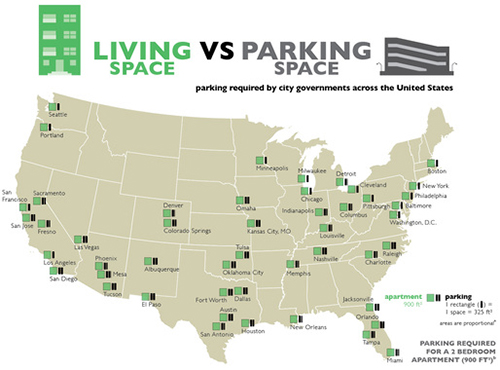The United States spent about a century getting to the point where cars — and the ability to put cars somewhere near attractions — were more valuable than people themselves. Now it might need to spend about 50 years trying to reverse that conceptual trend. Get this: you need about 300 square feet of asphalt just for a parking space. That’s the size of a studio apartment in NYC, or roughly enough space for 10 bicycles. According to that same CityLab article, there’s a chance that the number of parking spaces in the United States alone is roughly approaching 2 billion (with a b). But now you have a few emerging trend lines — first of all, millennials seem to want walkability and good public transportation out of the cities they’ll eventually settle in, businesses want to be in the cities that millennials want to be in (soon to be the bulk of the workforce), the real estate market is embracing walkable urban places right now, you’re seeing a little bit of a push towards Bus Rapid Transit, and cities are struggling with what to do with highway space and neighborhood breakdown now. All that means we might be nearing a tipping point in terms of how we look at urban transportation in America — and the answer (a small part of the answer, at least) could come from our dapper neighbor to the east, Paris.
Via this cool site (Reinventing Parking), Paris has a policy whereby if a development is 500 meters from a metro stop, there’s no obligation to build parking from the developer (but they can choose to). This could work in some U.S. cities, although not a ton of them, admittedly. Cities like Berlin (per that same site) have basically abolished parking minimums (the need for there to be a set number of parking spaces associated with a development), and if you talk to a good number of New York/Brooklyn hipsters, they’ll tell you that Berlin is “a place to be” (people are moving there). Berlin has good public transportation, so this is somewhat feasible.
What if this happened in the U.S.?
In certain cities, it might be a lot more challenging; there are definitely very car-centric cities in the United States, such as Dallas, Los Angeles, and Miami (although all have light rail and bus systems that are certainly commendable, especially compared to 10-15 years ago). But if we abolished parking minimums like a Berlin or Paris, we could encourage more people to reach events/shopping via public transportation, walking or bike — and that’s good for the environment (and the culture of a city!), even if it’s a bit more annoying to take your groceries home on foot or via bike than in your SUV.
Sao Paolo is the first mega-city in the developing world to get on board with this, and Edmonton is dealing with it in the context of who owns the parking on front-facing streets. San Francisco is struggling with this too, and God knows Los Angeles always has.
It’s an interesting thing to think about — how do people really get around in your city, and how did they 20 years ago vs. how they might 20 years from now? Things are necessarily changing. Cities have to make sure they adapt.
